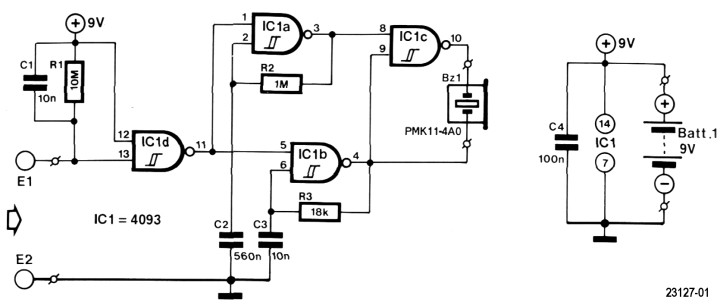Small Circuits Revival (44): Bath-Is-Full Detector
September 30, 2020
on
on
Bath-Is-Full Detector
Idea: Elektor LabsA clogged or otherwise defective bathtub overflow tube can result in a bathroom flood. That’s already not cool when it concerns your own home only, but it is even worse when you live in an appartment and the downstairs neighbors too have to deal with your bath water. Mishaps like that can quickly become costly. An acoustic warning to signal that the bathtub is full is therefore not a superfluous luxury.
Such a device doesn’t have to be complicated. When we consider that tap water is a good conductor due to the minerals dissolved in it (distilled water, on the other hand, is an insulator!), the solution is obvious: use two electrodes as a water-controlled switch. As soon as the water in the tub reaches a predefined height, the ‘switch’ is closed and an alarm (read: buzzer) is activated. And that is exactly what the simple circuit of Figure 1 does.

E1 and E2 on the left in the diagram are both electrodes (metal pins or something similar). As long as they are not immerged, there is no connection between E1 and E2 and both inputs of IC1d will be high. Its output will then be low, blocking both oscillators (the circuits around IC1a and IC1b).
As soon as there is a watery connection between E1 and E2, pin 13 of IC1d is pulled low, its output becomes high and both oscillators are released. IC1b now produces a square wave with a frequency of about 4 kHz, and IC1a a square wave with a frequency of about 0.5 Hz. AC-buzzer Bz1 is driven by the 4 kHz signal, which makes it produce a loud sound.
Amplitude modulation
But what is the function of the 0.5-Hz oscillator, and what does IC1c do? When pin 8 of IC1b is pulled high by the output of the 0.5 Hz oscillator, IC1c behaves as an inverter, inverting the 4-kHz signal. The signal on IC1c’s output (pin 10) then has opposite phase compared to the signal on IC1b’s output (pin 4). When, on the other hand, pin 8 of IC1c is low, this port’s output is constant high. The result is 0.5-Hz amplitude modulation of the buzzer signal (do not forget that we use an AC-buzzer!).Three more comments
First of all, the circuit has more applications than bath-full indicator. Secondly, when idle the circuit draws no current. An on/off switch is therefore not necessary. And third: as far as we know, the buzzer mentioned in the schematic is still available for little money at AliExpress.Read full article
Hide full article


Discussion (0 comments)